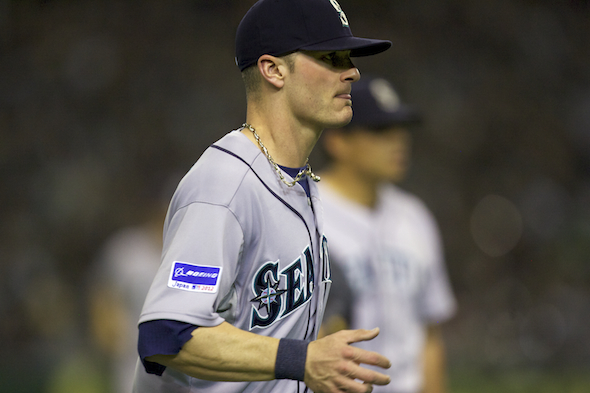
Tampa Bay outscored the Mariners 15-10 in the four-game series at Tropicana Field in large part because Seattle (which tried an all-lefty lineup card Thursday, the first time the Mariners have tried that since since 1983), went 4-for-23 (.174 BA) with runners in scoring position, left 29 batters stranded and whiffed 46 times.
That’s a whole lot of nothing, even by the Mariners’ abysmal historical standards — especially the RISP number. While the Mariners already have 25 home runs vs. the 29 they hit through the end of May in 2011, they have done next-to-zilch in terms of situational hitting.
Chief offenders include SS Brendan Ryan (0-for-26), who is batting .050 with runners poised to plate. Ichiro (4-for-24) and Justin Smoak (4-for-24) are at .167. Compared to those guys, Chone Figgins, 0-for-his-last-18 and now batting .189, is practically Lou Gehrig. Figgins is at .176 (3-for-17). Collectively, Ryan, Ichiro, Smoak and Figgins are at .141 (12-for-85).
The worst single-season major league performance by a Seattle hitter occurred in 1969, when Ray Oyler of the ill-fated Pilots hit .165 (BA) and .183 with runners in scoring position. Ten years after woodless wonder Oyler left the scene, Mario Mendoza came along and hit .198 for the 1979 Mariners, establishing the nationally infamous Mendoza Line.
Mendoza had a higher batting average in 1979 than Figgins, and also had a better RISP number — .196 — than Ryan, Ichiro, Smoak and Figgins together, .141. Figgins is in the process of splitting the difference between Oyler and Mendoza (he’s already exploring Oylerish BA territory).
The Mariners (11-16), who commence a three-game series with the Minnesota Twins at Safeco Field Friday, have 135 games remaining, ample time to create a history of positives when they get a man in position to slap five at home. But for now, this is how the Mariners’ current RISP stacks up to every Mariners team that lost 95 or more games in a season:
Worst RISP Numbers By 95+-Loss Mariners Teams
| Year | Manager | Record | AB | H | RISP |
|---|---|---|---|---|---|
| 2012 | Eric Wedge | 11-16 | 227 | 49 | .216 |
| 2011 | Eric Wedge | 67-95 | 1237 | 275 | .222 |
| 2010 | Don Wakamatsu | 61-101 | 1266 | 286 | .226 |
| 1983 | Rene Lachemann | 60-102 | 1242 | 284 | .229 |
| 1978 | Darrell Johnson | 56-104 | 1313 | 335 | .237 |
| 1980 | Darrell Johnson | 59-103 | 1339 | 335 | .250 |
| 2008 | John McLaren | 61-101 | 1346 | 346 | .257 |
| 2004 | Bob Melvin | 63-99 | 1431 | 376 | .263 |
| 1986 | Chuck Cottier | 67-95 | 1327 | 350 | .264 |
| 1992 | Bill Plummer | 64-98 | 1343 | 363 | .268 |
| 1979 | Darrell Johnson | 67-95 | 1439 | 569 | .272 |

2 Comments
Seems like more of the same. As fans we continue to hope for better days ahead, yet after Lou’s tenure they never arrive. While liking some of what Jack has done it still looks as though several more years of patience will be required while the best we can hope for is the M’s stay one spot above the basement. Is a major shake up coming? At the very least it looks like the M’s will soon be eating another large contract. The questions are will the young players on the team improve or have they already reached their potential and who can we bring up to “jump start” and give this offense some consistency?
What makes Lou’s tenure even more impressive is that he managed in two different home fields, both as different to one another as they come. He was able to adjust to Safeco after being in the hitting friendly confines of the Kingdome. So I guess the question is does the current club play to Safeco Field’s strength’s? I don’t see them execute the small ball gameplan too often.
Looking at this list the teams are pretty evenly divided between the Kingdome and Safeco Field but then the M’s haven’t played at Safeco as long as they did in the Kingdome. IMO, they need speedy contact hitters who can get on base and know how to use the field. Maybe the M’s should trade Brandon League to the Yankees? I’ve love to see Cashman’s face if Jack called him with that offer after what happened with Pineda.